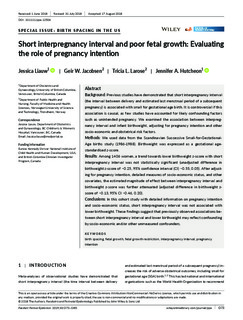| dc.contributor.author | Liauw, Jessica | |
| dc.contributor.author | Jacobsen, Geir Wenberg | |
| dc.contributor.author | Larose, Tricia L | |
| dc.contributor.author | Hutcheon, Jennifer A | |
| dc.date.accessioned | 2019-09-09T06:02:17Z | |
| dc.date.available | 2019-09-09T06:02:17Z | |
| dc.date.created | 2018-08-18T16:11:48Z | |
| dc.date.issued | 2018 | |
| dc.identifier.citation | Paediatric and Perinatal Epidemiology. 2018, 33 (1), O73-O85. | nb_NO |
| dc.identifier.issn | 0269-5022 | |
| dc.identifier.uri | http://hdl.handle.net/11250/2613834 | |
| dc.description.abstract | Background
Previous studies have demonstrated that short interpregnancy interval (the interval between delivery and estimated last menstrual period of a subsequent pregnancy) is associated with small for gestational age birth. It is controversial if this association is causal, as few studies have accounted for likely confounding factors such as unintended pregnancy. We examined the association between interpregnancy interval and infant birthweight, adjusting for pregnancy intention and other socio‐economic and obstetrical risk factors.
Methods
We used data from the Scandinavian Successive Small‐for‐Gestational‐Age births study (1986‐1988). Birthweight was expressed as a gestational age‐standardised z‐score.
Results
Among 1406 women, a trend towards lower birthweight z‐score with short interpregnancy interval was not statistically significant (unadjusted difference in birthweight z‐score of −0.25, 95% confidence interval (CI) −0.55, 0.05). After adjusting for pregnancy intention, detailed measures of socio‐economic status, and other covariates, the estimated magnitude of effect between interpregnancy interval and birthweight z‐score was further attenuated (adjusted difference in birthweight z‐score of −0.13, 95% CI −0.46, 0.20).
Conclusions
In this cohort study with detailed information on pregnancy intention and socio‐economic status, short interpregnancy interval was not associated with lower birthweight. These findings suggest that previously observed associations between short interpregnancy interval and lower birthweight may reflect confounding by socio‐economic and/or other unmeasured confounders. | nb_NO |
| dc.language.iso | eng | nb_NO |
| dc.publisher | Wiley | nb_NO |
| dc.rights | Attribution-NonCommercial-NoDerivatives 4.0 Internasjonal | * |
| dc.rights.uri | http://creativecommons.org/licenses/by-nc-nd/4.0/deed.no | * |
| dc.title | Short interpregnancy interval and poor fetal growth: evaluating the role of pregnancy intention | nb_NO |
| dc.type | Journal article | nb_NO |
| dc.type | Peer reviewed | nb_NO |
| dc.description.version | publishedVersion | nb_NO |
| dc.source.pagenumber | O73-O85 | nb_NO |
| dc.source.volume | 33 | nb_NO |
| dc.source.journal | Paediatric and Perinatal Epidemiology | nb_NO |
| dc.source.issue | 1 | nb_NO |
| dc.identifier.doi | 10.1111/ppe.12506 | |
| dc.identifier.cristin | 1602898 | |
| dc.description.localcode | This is an open access article under the terms of the Creative Commons Attribution-NonCommercial-NoDerivs License, which permits use and distribution in any medium, provided the original work is properly cited, the use is non-commercial and no modifications or adaptations are made. © 2018 The Authors | nb_NO |
| cristin.unitcode | 194,65,20,0 | |
| cristin.unitname | Institutt for samfunnsmedisin og sykepleie | |
| cristin.ispublished | true | |
| cristin.fulltext | original | |
| cristin.qualitycode | 1 | |

